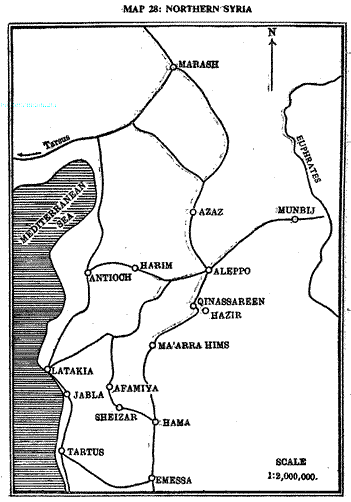|
At Qinassareen the part
of the Roman garrison which had not accompanied Meenas to Hazir
shut itself up in the fort. As soon as Khalid arrived, he sent a
message to the garrison: "If you were in the clouds, Allah
would raise us to you or lower you to us for battle." 1
Without further delay Qinassareen surrendered to Khalid. The Battle
of Hazir and the surrender of Qinassareen took place about June
637 (Jamadi-ul-Awwal, 16 Hijri). 2
Abu Ubaidah now joined Khalid at Qinassareen,
and the army marched to Aleppo, where a strong garrison under a
Roman general named Joachim held the fort. This general, following
the same line of thought as the commander of Qinassareen, set out
to meet the Muslims in the open and clashed with the Mobile Guard
6 miles south of the city. A bloody engagement took place here,
in which the Romans were worsted; and Joachim; now wiser, pulled
back in haste and regained the safety of the fort.
Aleppo consisted of a large walled city
and a smaller but virtually impregnable fort outside the city atop
a hill, a little more than a quarter of a mile across, surrounded
by a wide moat. The Muslims moved up and laid siege to the fort.
Joachim was a very bold commander and launched several sallies to
break the siege, but received heavy punishment every time. After
a few days of this, the Romans decided to remain in the fort and
await such help as Heraclius might be able to send. Heraclius however,
could send none; and four months later, around October 637, the
Romans surrendered on terms. The soldiers of the garrison were allowed
to depart in peace; but Joachim would not go. He became a Muslim
and elected to serve under the banner of Islam. In fact, over the
next few weeks, he proved a remarkably able and loyal officer, and
fought gallantly under various Muslim generals.
Once Aleppo was taken, Abu Ubaidah sent
a column under Malik Ashtar to take Azaz on the route to 'Rome'.
The region which the Muslims called Rome included the area which
is now Southern Turkey east of the, Taurus Mountains. Malik, assisted
by Joachim, captured Azaz and signed a pact with the local inhabitants,
whereafter he returned to Aleppo. The capture and clearance of Azaz
was essential to ensure that no large Roman forces remained north
of Aleppo, whence they could strike at the flank and rear of the
Muslims as the next major operation was launched. As soon as Malik
rejoined the army, Abu Ubaidah marched westwards to capture Antioch.
(See Map 28 below)

The army moved via Harim and approached
Antioch from the east. Some 12 miles from the city, at Mahruba,
where a bridge of iron spanned the River Orontes (now known as Nahur-ul-Asi),
the Muslims came up against a powerful Roman army-the defenders
of Antioch. A major battle was fought here, the details of which
are not recorded, and the Romans were soundly thrashed by Abu Ubaidah,
Khalid again playing a prominent role with his Mobile Guard. With
the exception, of Ajnadein and Yarmuk, the Roman casualties here
are believed to have been the highest in the Syrian Campaign, and
the remnants of the Roman army went fleeing in disorder to the city.
The Muslims moved up and laid siege to Antioch, but not many days
had passed before the greatest city of Syria, the capital of the
Asian Zone of the Eastern Roman Empire, surrendered to the Muslims.
Abu Ubaidah entered Antioch on October 30, 637 (the 5th of Shawwal,
16 Hijri). The defeated Roman soldiers were allowed to depart in
peace.
1. Tabari: Vol. 3, p. 98.
2. Qinassareen lay in a South-South-Westerly
direction from Aleppo, 20 miles by road and about 18 as the crow flies.
It was built on a low ridge which runs astride the present Aleppo-Saraqib
road, but most of it was on the Southern slope of the Eastern part
of the ridge, i.e. on the East side of the road. The ridge
is now known as Al Laees, and this is also the name of a small village
which stands on that was probably the South-Eastern corner of Qinassareen.
The visitor to Qinassareen today imagines that he can see the ruins
of the city-ancient ruins such as one sees in many places in Syria.
But on closer examination he finds that they are not ruins but immense
whitish rocks and caves shaped by nature into semblance of ruins.
Actually nothing remains of Qinassareen-not a stone, not a brick.
|
